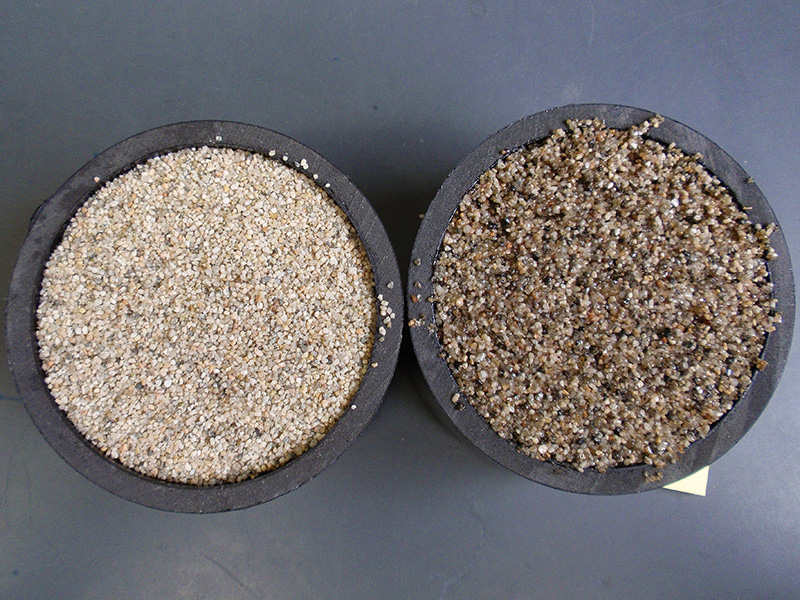September 30, 2020 – Farmers often need to regulate soil temperature, reduce weeds, and minimize water loss. Agricultural mulch can help farmers do so.
But the plastic in commonly used agricultural mulch can degrade soil and water quality. Microplastics can even enter the food chain.
In a new study, researchers tested a more sustainable approach to lowering evaporation from soils. Instead of plastic, they used sand particles coated with soybean oil. This research was published in the Vadose Zone Journal, a publication of the Soil Science Society of America.
In laboratory experiments, soil treated with a thin layer of soybean oil-coated sand had up to 96% lower evaporative water loss compared to bare soil.
“These findings show that oil-coated sand has the potential to be developed into a sustainable alternative to plastic film mulch”, says Michael Nicholl. Nicholl is an associate professor at the University of Nevada in Las Vegas.
Plastic mulch is made of polyethylene, a hydrocarbon-based product. “It carries long-term environmental consequences,” says Nicholl. “These effects span all stages of its lifecycle: production, installation, disposal.”
Biobased soil coatings – such as soybean oil – could be low-impact alternatives to polyethylene mulch while performing at similar levels.
To make the coated sand, researchers mixed roughly equal volumes of sand and oil. Then they heated the mixture for about an hour and allowed it to cool. Finally, the mixture was washed with water and dried.
This process chemically modifies the oil, partially polymerizing it. The partially polymerized oil forms a coating around individual sand particles.
Initial tests indicated that this oil-coated sand is quite effective at reducing water loss through evaporation.
Water evaporates from soils in two different ways. The oil-coated sand reduced the more potent path of evaporative water loss.
“As an analogy, think of soil as a damp sponge,” says Nicholl.
If you set the sponge in a puddle of water, the water will soak up into the sponge. Eventually, the water will rise to the top of the sponge. Then it will evaporate into the air.
Similarly, wicking action carries water to the soil surface. There, it evaporates directly into the air.
In the second mechanism, the water is unable to wick all the way to the soil surface. Instead, it evaporates into the air within the soil. This humid air must diffuse upwards through the soil and ultimately escape into the atmosphere.
“This second mechanism is much less efficient than the first,” says Nicholl. “It results in lower rates of evaporation.”
Nicholl and his team wanted to test if a surface layer of oil-coated sand would reduce either way of evaporation from underlying soils.
He and his research colleague filled PVC columns with test soils. Then, they layered oil-coated sand on top of the columns but left one column bare. Finally, they saturated these columns with water.
Each column was then tested for evaporative water loss.
The oil-coated sand reduced the amount of water wicking upwards, thus minimizing the first evaporation mechanism.
Researchers weren’t sure if it would be possible to coat single sand particles with oil. There was a danger the sand and oil would be cemented together.
“We found instead that individual sand grains can be coated with partially-polymerized oil,” says Nicholl.
That’s important because any soil treatment aimed at reducing water loss also has to allow water – via rainfall or irrigation – to enter the soil. A sheet of oil-coated sand fused together could stop water from entering the soil.
Laboratory tests showed that liquid water could pass through the layer of oil-coated sand. That suggests this material will not hinder irrigation efforts.
“Though initial results are encouraging, there are many questions still to answer,” says Nicholl.
For example, this bio-based mulch has not been exposed to outdoor environments. “So, we don’t have adequate data to determine how this material weathers in an agricultural setting,” says Nicholl.
Researchers are exploring procedures to measure the longevity of coated materials in various settings. These include arid environments, temperate environments, and biologically active soils.
“We hope this work inspires further inquiry into the practical applications of oil-coated materials,” says Nicholl.
